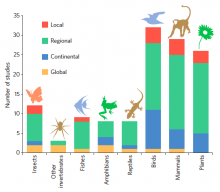Assessing species vulnerability to climate change

The effects of climate change on biodiversity are increasingly well documented, and many methods have been developed to assess species’ vulnerability to climatic changes, both ongoing and projected in the coming decades. To minimize global biodiversity losses, conservationists need to identify those species that are likely to be most vulnerable to the impacts of climate change. In this Review, we summarize different currencies used for assessing species’ climate change vulnerability. We describe three main approaches used to derive these currencies (correlative, mechanistic and trait-based), and their associated data requirements, spatial and temporal scales of application and modelling methods. We identify strengths and weaknesses of the approaches and highlight the sources of uncertainty inherent in each method that limit projection reliability. Finally, we provide guidance for conservation practitioners in selecting the most appropriate approach(es) for their planning needs and highlight priority areas for further assessments.
Pacifici, M., W. B. Foden, P. Visconti, J. E. M. Watson, S. H. M. Butchart, K. M. Kovacs, B. R. Scheffers, D. G. Hole, T. G. Martin, H. R. Akçakaya, R. T. Corlett, B. Huntley, D. Bickford, J. A. Carr, A. A. Hoffmann, G. F. Midgley, P. Pearce-Kelly, R. G. Pearson, S. E. Williams, S. G. Willis, B. Young, and C. Rondinini. 2015. Assessing species vulnerability to climate change. Nature Climate Change 5:215–224.
